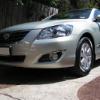-
Latest Postings
-
0
Need Advice please
Hi, can anyone tell me if the shocks from a camry 2011 fit a 2013 camry? Also my car surges while i accelerate, ive changed the fuel pump and filter still does it, im wondering it could be the fuel injectors? Are they easy to clean? -
19
FUEL WARNING MESSAGE
Kanga, You wouldn't believe it, I found a pump at a Victorian wrecker. He posted it to me but to the wrong address. It was 10 days before I found this out. I went to the wrong address and they said the didn't see it. Austpost is adamant it was delivered. The wrecker fortunately has another one. So, I haven't taken the old one out yet. -
19
FUEL WARNING MESSAGE
I was hoping for a trivial issue like a blockage, but seems Im out of luck.... -
19
FUEL WARNING MESSAGE
Just tested before - I think its dead. No noise - nothing. I also note that the power supply I have actually delivers a really high-pitched noise when it is on. When you connect it to something, that noise goes away. In this case, when I connect to the terminals, the noise remains. I'm going to have to get inside to look further. Unfortunately, I simply don't have the room to do a job like that. Geoff, did you have any luck getting yours out through the inspection hole mate? I'd seen a few Lexus owners actually cut the inspection hole to get this part out without dropping the tank. Each to their own, but I'm looking to avoid anything that invasive.... -
0
Typical Price for a Replacement Key - 2000 Toyota Torago
Just let me preface this by saying I know very little about cars in general, so apologies if I get some basic info wrong here. Ive lost the key to my 2000 Toyota Torago. I rang up a local locksmith to get a quote on a replacement key, and apparently it'll cost $1200 for two keys?? The old key didn't even have any electronics in it, it was just a basic key. Not button unlock or anything. I've gotten an electronic car key cut before and it only came to $400! This price for a key without a chip seems extortionate to me. Can someone please let me know if this price is normal, and if so why the hell its so expensive? Thanks in advance for the help! Here's all the information I think is relevant to the car (let me know if more is needed): TOYOTA TARAGO ACR30 II 16V 2.4L 2AZ-FE DOHC 16v Petrol 4cyl 115kW MPV FWD [02/00-02/06] Compliance plate / RAV entry date: 04/2000 -
19
FUEL WARNING MESSAGE
On my 2002 Prado, the fuel transfer pump has a fuel filter which can block, causing increasingly less fuel transfer between the tanks. It may be the same for the Cruiser too. I have not yet had an issue with mine even at 250000km, but that is low mileage for a 2002 Prado. I hope that you have a filter that can be easily replaced. It could save you a pump replacement. -
1
2002 Hilux Engine Replacement
Unless you can identify which engine your Hilux has now, you may be better off finding a good 5LE engine and return it to stock. Nice to have a Turbo diesel though. Have you tried taking a photo of the engine and posting it so others can advise what engine you have. It may be better to have your engine overhauled. If you can locate the engine number (should be on the registration papers if the engine swap was done legit), you might be able to ID the engine that way too. Do you know why the engine seized? It may be possible to overhaul your engine cheaper than replacing it. -
0
Transmission clunk
Hi all, Recently completed a long drive. Check engine light came on, traction control off light came on, unable to use cruise control. Pulled immediately over all oil level were good and no leaks. then when accelerating through the gears ( automatic Prado ) hearing and feeling a clunk on each gear ( like it was hard to select). Prado is unable to go into 5th & 6th gear. Maxed out in 4th gear at 90km/h @ 2500rpm. Later in the drive DPF light came on though I have a July 2015 build. DPF introduced in October 2015 that I am aware off. Any ideas at all would be grateful! -
19
FUEL WARNING MESSAGE
Yes, with 12v applied to the pump you can definitely hear it whirring if it is working. Kind regards Geoff -
0
Yaris Cross roof rack
Hi all, I’m looking at purchasing a Yaris Cross GXL however I can’t seem to find any official roof rack for the car On the Toyota website it doesn’t show a roof rack protruding like the Corolla Cross GXL I know you can get roof racks that slide under the door however I don’t see any official listing Interestingly enough Toyota offer an official bike rack for the Yaris, Corolla hatch etc but not the Yaris Cross Rhino-Rack offer a third party roof rack for the “TOYOTA Yaris Cross Gen1 5dr SUV Bare Roof” but I’m a bit hesitant to use a 3rd party roof rack on a brand new car. Do you know if this would cause any warranty issues etc? Another option would be to get a Corolla Cross GXL. However the Yaris Cross would be perfect if it could have a roof rack as I don’t need the extra size, engine and price point of the Corolla Cross. Happy to hear your thoughts
-



Recommended Posts
Join the conversation
You can post now and register later. If you have an account, sign in now to post with your account.